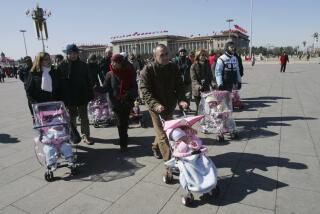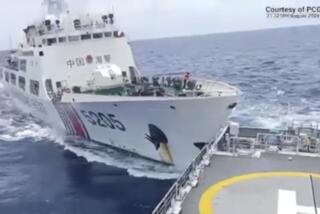China Won’t Let U.S. Spy Aircraft Be Flown Home
- Share via
BEIJING — Hours after the U.S. sent up its first reconnaissance flight in a month off the Chinese coast, the government here said Tuesday that it will not allow a damaged American spy plane stranded in southern China to be flown home.
Although Beijing did not rule out an eventual return of the crippled U.S. Navy EP-3, which has been at a military air base on Hainan island since an April 1 midair collision, Chinese officials said the craft will not be returned under its own power.
“The Chinese side has several times stated clearly in relevant Sino-U.S. negotiations that it is impossible for the U.S. EP-3 plane to fly back to [the] U.S. from Hainan island,” said Foreign Ministry spokesman Sun Yuxi, according to the official New China News Agency.
His comment came less than a day after Washington announced that it had resumed aerial reconnaissance missions near China.
On Monday, U.S. defense officials said, an Air Force RC-135 flew off the northeastern Chinese coast on an intelligence-gathering mission similar to the one that the EP-3 was on when it collided with a Chinese fighter jet. A Chinese pilot died in the crash, and the 24 crew members of the hobbled EP-3 were forced to make an emergency landing on Hainan, where they were detained by authorities for 11 days.
China regards the American surveillance flights as a provocative infringement on its sovereignty and has demanded that they be halted. Washington should “draw a lesson” from the April 1 collision and “correct such wrongdoings,” Sun said.
The Bush administration insists that it will continue the reconnaissance missions, which take place in international airspace.
The State Department offered little insight Tuesday on the status of talks about the return of the spy plane.
“We continue to discuss it. But playing into this back and forth in the media is not the way these things get solved,” said a senior State Department official who asked to remain anonymous for diplomatic reasons.
On Sunday, Defense Secretary Donald H. Rumsfeld expressed hope that the damaged EP-3 could be repaired on the ground and then flown home. A team of U.S. technicians examined the plane last week and concluded that the $80-million aircraft could fly again.
“The preliminary view is that it may be possible to repair it sufficiently to fly it out, but that’s not clear yet,” Rumsfeld told NBC-TV’s “Meet the Press.”
Although Beijing did not say why it rejected the idea, allowing the plane to return on its own power might be considered too much of a loss of face for the Communist regime. The government is eager to appear strong in the eyes of an increasingly nationalistic public.
“The U.S. side should take a pragmatic and constructive attitude so that the issue on handling the U.S. plane could be properly settled,” Sun said.
Alternatives include disassembling the EP-3 and taking it home in parts. Pentagon officials say that Chinese military experts probably have combed the plane and carted off whatever intelligence they could find.
Monday’s surveillance flight passed without incident. No Chinese fighters were sent to intercept the RC-135, which was unarmed and unaccompanied by warplanes, U.S. officials said.
The April 1 collision and the ensuing diplomatic standoff dragged Sino-U.S. relations to their lowest point in two years. It was followed by a significantly expanded U.S. arms sale offer to Taiwan, which Beijing considers a breakaway province.
Times staff writer Robin Wright in Washington contributed to this report.
‘The Chinese side has several times stated clearly . . . that it is impossible for the U.S. EP-3 plane to fly back to [the] U.S. from Hainan island.’
Sun Yuxi, Chinese Foreign Ministry spokesman
More to Read
Sign up for Essential California
The most important California stories and recommendations in your inbox every morning.
You may occasionally receive promotional content from the Los Angeles Times.














